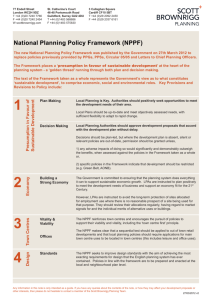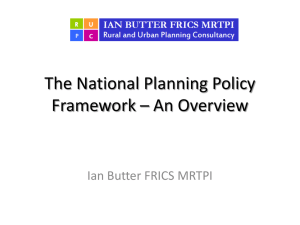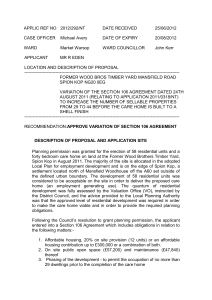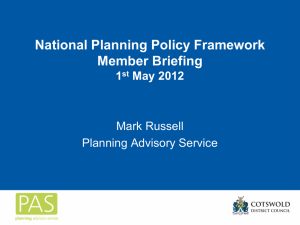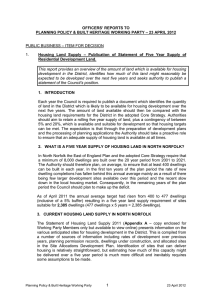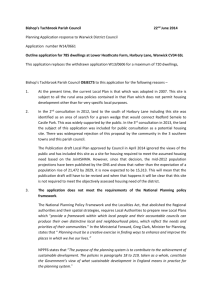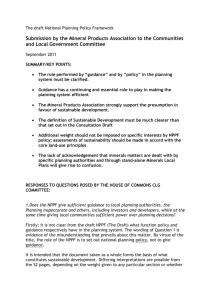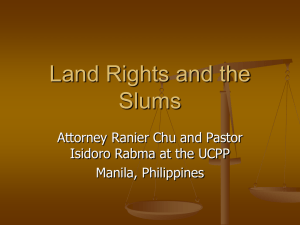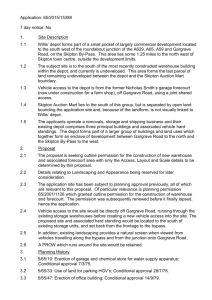Whole Doc
advertisement
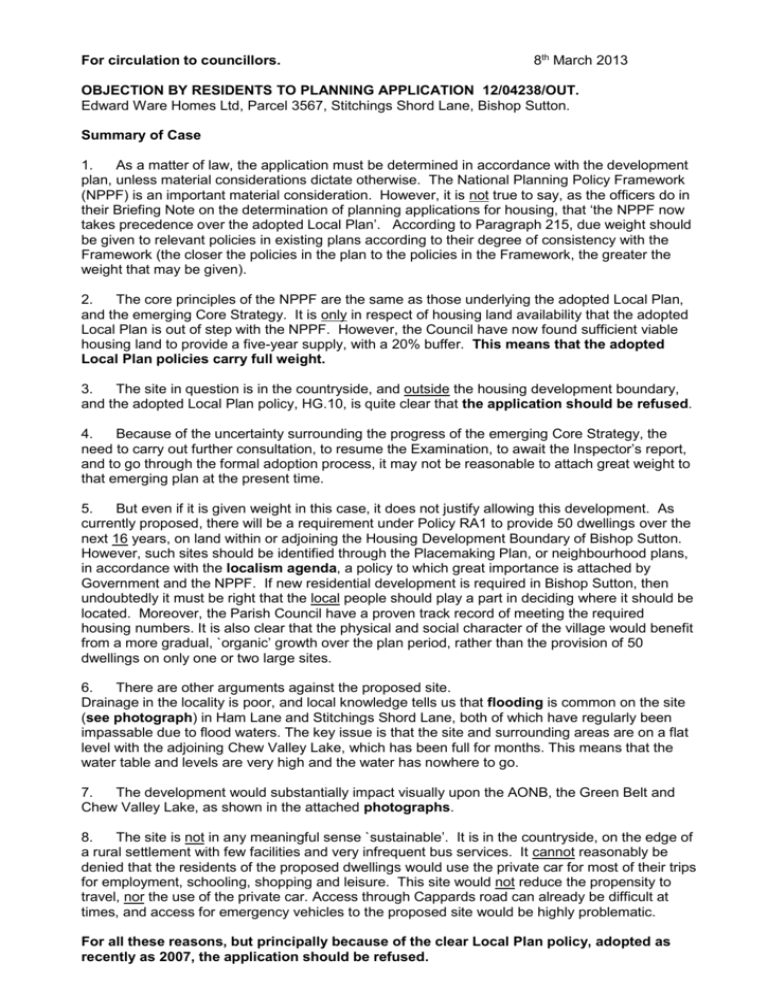
For circulation to councillors. 8th March 2013 OBJECTION BY RESIDENTS TO PLANNING APPLICATION 12/04238/OUT. Edward Ware Homes Ltd, Parcel 3567, Stitchings Shord Lane, Bishop Sutton. Summary of Case 1. As a matter of law, the application must be determined in accordance with the development plan, unless material considerations dictate otherwise. The National Planning Policy Framework (NPPF) is an important material consideration. However, it is not true to say, as the officers do in their Briefing Note on the determination of planning applications for housing, that ‘the NPPF now takes precedence over the adopted Local Plan’. According to Paragraph 215, due weight should be given to relevant policies in existing plans according to their degree of consistency with the Framework (the closer the policies in the plan to the policies in the Framework, the greater the weight that may be given). 2. The core principles of the NPPF are the same as those underlying the adopted Local Plan, and the emerging Core Strategy. It is only in respect of housing land availability that the adopted Local Plan is out of step with the NPPF. However, the Council have now found sufficient viable housing land to provide a five-year supply, with a 20% buffer. This means that the adopted Local Plan policies carry full weight. 3. The site in question is in the countryside, and outside the housing development boundary, and the adopted Local Plan policy, HG.10, is quite clear that the application should be refused. 4. Because of the uncertainty surrounding the progress of the emerging Core Strategy, the need to carry out further consultation, to resume the Examination, to await the Inspector’s report, and to go through the formal adoption process, it may not be reasonable to attach great weight to that emerging plan at the present time. 5. But even if it is given weight in this case, it does not justify allowing this development. As currently proposed, there will be a requirement under Policy RA1 to provide 50 dwellings over the next 16 years, on land within or adjoining the Housing Development Boundary of Bishop Sutton. However, such sites should be identified through the Placemaking Plan, or neighbourhood plans, in accordance with the localism agenda, a policy to which great importance is attached by Government and the NPPF. If new residential development is required in Bishop Sutton, then undoubtedly it must be right that the local people should play a part in deciding where it should be located. Moreover, the Parish Council have a proven track record of meeting the required housing numbers. It is also clear that the physical and social character of the village would benefit from a more gradual, `organic’ growth over the plan period, rather than the provision of 50 dwellings on only one or two large sites. 6. There are other arguments against the proposed site. Drainage in the locality is poor, and local knowledge tells us that flooding is common on the site (see photograph) in Ham Lane and Stitchings Shord Lane, both of which have regularly been impassable due to flood waters. The key issue is that the site and surrounding areas are on a flat level with the adjoining Chew Valley Lake, which has been full for months. This means that the water table and levels are very high and the water has nowhere to go. 7. The development would substantially impact visually upon the AONB, the Green Belt and Chew Valley Lake, as shown in the attached photographs. 8. The site is not in any meaningful sense `sustainable’. It is in the countryside, on the edge of a rural settlement with few facilities and very infrequent bus services. It cannot reasonably be denied that the residents of the proposed dwellings would use the private car for most of their trips for employment, schooling, shopping and leisure. This site would not reduce the propensity to travel, nor the use of the private car. Access through Cappards road can already be difficult at times, and access for emergency vehicles to the proposed site would be highly problematic. For all these reasons, but principally because of the clear Local Plan policy, adopted as recently as 2007, the application should be refused. Detailed Report 1. Site location and characteristics 1.1 The site comprises agricultural land on the edge of Bishop Sutton. The site lies outside the Housing Development Boundary for the village. It is close to, but outside, the Green Belt and an Area of Outstanding Natural Beauty. It is within the Forest of Avon and a Water Source Protection Area. Vehicle access is via Cappards Road, which serves an existing modern housing estate. 1.2 Bishop Sutton village has limited facilities, including a village shop and a primary school, and is served by infrequent buses. 2. Key Issues 2.1 Primacy of the development plan and existing policies 2.1.1 Section 38(6) of the Planning and Compulsory Purchase Act 2004 requires that applications for planning permission should be determined in accordance with the development plan, unless material considerations indicate otherwise. 2.1.2 In this case, the development plan comprises the Regional Planning Guidance for the South West (soon to be abolished), saved policies from the Joint Replacement Structure Plan, saved policies from the B&NES Local Plan, adopted in 2007, and the adopted Joint Waste Core Strategy. Of these policies, the most relevant in this case are those contained in the Local Plan, in particular HG.4 (housing within rural settlements), HG.10 (housing outside rural settlements), and T.1 (reduce dependency on the private car and encourage movement by public transport). Policies GB.2 (Green Belt), NE.2 (AONB), NE.5 (Forest of Avon), NE.13 (Water Source Protection Area) are also relevant to the case. 2.1.3 Policy HG.4 permits new residential development within the Housing Development Boundaries (HDB) of rural settlements like Bishop Sutton. Policy HG.10 prohibits new housing in the countryside (except for agriculture and forestry). The application site lies in the countryside, outside the HDB. The application should therefore be refused, unless other material considerations outweigh the policy. 2.2 National Policy 2.2.1 The National Planning Policy Framework (NPPF) is an important material consideration. However, it is not true to say, as the Council do in their Briefing Note on the determination of planning applications for housing, that `the NPPF now takes precedence over the adopted Local Plan’. The precise situation is less clear cut. According to Paragraph 215, due weight should be given to relevant policies in existing plans according to their degree of consistency with the Framework (the closer the policies in the plan to the policies in the Framework, the greater the weight that may be given). 2.2.2 The NPPF restates and perpetuates the core principles which underlie the existing development plan. In particular, it says that development should be plan-led, and that planning should: seek high quality design and a good standard of amenity for existing and future occupants. take account of the differing character of different areas. protect the Green Belt. recognise the intrinsic character and beauty of the countryside. support the transition to a low carbon future. 2 take account of flood risk. encourage the effective use of land by reusing land that has been previously developed (brownfield land). conserve and enhance the natural environment. actively manage patterns of growth to make the fullest possible use of public transport, walking and cycling, and focus significant development in locations which are or can be made sustainable. 2.2.3 All of this is familiar and embodied in the existing development plan (and indeed in the emerging Core Strategy). The only possible respect in which adopted Local Plan policy might not be in accord with the NPPF is the lack of a five-year housing land supply (see below). 2.2.4 The most important new element in the NPPF is that planning should empower local people to shape their surroundings. B&NES are planning to do this through their Placemaking Plan (see below). 2.3 Housing Land Availability 2.3.1 A key element of the NPPF (an element which is not new, but which is receiving much greater emphasis than in the recent past) is the requirement for planning authorities to maintain a five-year (plus) housing land supply. This is the sole element of the NPPF which might reasonably justify departing from the existing local plan policies in this case. 2.3.2 However, B&NES now say that they have identified sufficient viable sites to meet the fiveyear requirement, with a 20% buffer. Unless the Cappards Road site is specifically part of that identified supply of land (and there is no suggestion in the Council’s report that it is), there can be no logical reason or immediate requirement to release this land, which lies in the countryside outside the Housing Development Boundary of Bishop Sutton, contrary to adopted Local Plan policy. There is ample time for local consultations to be carried out in accordance with Government policy on localism to establish the most suitable site or sites for the 50 dwellings. Moreover, the local Parish Council already have a published housing policy, and can demonstrate a proven track record of managing new development and meeting the required housing numbers. 2.4 The Emerging Local Plan 2.4.1 The adopted Local Plan will be replaced in due course by a new Local Plan, consisting of a Core Strategy, which is presently the subject of an adjourned Examination, and a Placemaking Plan, which is in its earliest stages. 2.4.2 Because of the uncertainty surrounding the progress of the emerging Core Strategy, the need to carry out further consultation, to resume the Examination, to await the Inspector’s report, and to go through the formal adoption process, it may not be reasonable to attach great weight to that emerging plan at the present time. 2.4.3 But even if it is given weight in this case, it does not justify allowing this development. As currently proposed, there will be a requirement under Policy RA1 to provide 50 dwellings on land within or adjoining the Housing Development Boundary of Bishop Sutton. However, such sites should be identified through the Placemaking Plan or neighbourhood plans in accordance with the localism agenda, a policy to which great importance is attached by Government. If new residential development is required in Bishop Sutton, then undoubtedly it must be right that the local people should play a part in deciding where it should be located. Moreover, it is arguable that the physical and social character of the village would benefit from a more gradual, `organic’ growth over the plan period, rather than the provision of 50 dwellings on only one or two large sites. 3 2.5 Sustainability 2.5.1 In the NPPF, the presumption in favour of sustainable development is said to be a `golden thread’ running throughout plan-making and decision-taking. In essence, sustainability means meeting the needs of the present without compromising the ability of future generations to meet their own needs. Its most practical expression in planning terms has long been the requirement to reduce the need to travel, especially by private car. This site cannot be described as sustainable in any reasonable sense. It is in the countryside, on the edge of a rural settlement which has limited facilities, and infrequent bus services (for example only one bus a week to Bath leaving at 09.24 and returning at 14.31!). It cannot reasonably be denied that the residents of the proposed dwellings would use the private car for the majority of their trips for employment, schooling, shopping and leisure. This site would not reduce the propensity to travel, nor the use of the private car. It is not in any meaningful sense `sustainable’. 3 Other material considerations There are a number of other grounds for objecting to the development, which together amount to a substantial additional case against the proposal. 3.1 Flooding and drainage 3.1.1 Drainage in the locality is poor, and local knowledge tells us that flooding is common on the site itself (see photograph) in Ham Lane and parts of Stitchings Shord Lane, both of which have regularly been impassable due to flood waters over recent years. There have also been instances of sewage backing up into residents’ toilets. The key issue is that the site and surrounding areas are on a flat level with the adjoining Chew Valley Lake, which has been full for months. This means that the water table and levels are very high and the water has nowhere to go. Also, the replacement of open fields with hard surfaces would be likely to increase the risk of flooding in the area. It does not appear that provision would be made for dredging the existing open ditches in the locality. 3.2 Substantial Visual Impact upon the AONB and the Green Belt 3.2.1 The development would be visible from numerous points in the AONB and the Green Belt, including Chew Valley Lake which is a Special Protection Area and Site of Special Scientific Interest. It would be an alien feature in an attractive rural landscape. Both national and local policies seek to protect and enhance valued landscapes such as this (see point 2.2.2 above). Please see attached photographs. 3.3 Access, and noise / disturbance from traffic 3.3.1 Cars, vans and lorries are regularly parked on Cappards Road, as most houses only have one parking bay, meaning access is difficult particularly for large vehicles , and emergency vehicles would find it difficult or impossible to access the proposed development. 3.3.2 The traffic generated by 35 dwellings (with most households owning on average two cars), when concentrated upon a relatively narrow road, lined by houses, is bound to have a detrimental effect upon the amenity of the existing residents. The effects would be exacerbated by the presence of cars parked on street, which would cause passing vehicles to brake and accelerate, thereby generating additional noise. . 4 3.4 Highway safety 3.4.1 Cappards Road is at present a relatively quiet cul-de-sac where children can walk, cycle and use the play park in safety. Through traffic from an additional 35 dwellings would make it busier and less safe for existing residents. 3.4.2 The junction of Lovell Drive and Cappards Rd is said to be hazardous due to the poor sightlines caused by the high boundary walls. Additional traffic would increase the hazard. 3.6 Effect upon vegetation and wildlife 3.6.1 The site falls within the Forest of Avon where development must respect the existing and developing woodland setting. The illustrative details provided with this outline application do not demonstrate compliance with this requirement, and does not meet the objectives laid out in the NPPF (see point 2.2.2 above). 3.6.2 The area of land on the eastern boundary of the proposed development site is subject to a Section 106 agreement requiring a tree zone. This does not appear to have been recognised by the present proposal. 3.6.3 The site is rich in wildlife including birds, snakes, frogs, foxes and insects. It is an assembly point for migrating house martins. The loss of the site would be harmful to the natural environment, contrary to both national and local policies. 3.7 Loss of outlook and privacy for existing residents 3.7.1 The houses on the edge of the existing development would experience a dramatic change in outlook, to the detriment of the amenity of their occupiers. Moreover, it appears that the proposed development would re-locate an existing footpath several metres closer to the existing properties, reducing the privacy of the occupiers, increasing the possibility of noise and disturbance, and reducing security (as supported by the objection by Avon & Somerset police), 3.8 Shortage of places in the local primary school 3.8.1 The school is said to be over-subscribed and already has temporary buildings. 35 new dwellings of the size and type proposed would undoubtedly generate a demand for primary school places. It is unlikely that all the demand could be met locally, thereby increasing the need to travel by car. 3.9 Effect of past mining 3.9.1 The site appears to overlie former mine workings, which would need to be investigated before development could take place. The cost of investigation and possible remedial works could affect the viability of the site, and either delay its development or raise the price of the dwellings. There may be more suitable sites within or adjoining the village. 4. Conclusion Provided that there is a five-year (plus) supply of viable sites, a robust case can be made against this site, on the grounds that it is in the countryside, outside the defined Housing Development Boundary, in a location which is not sustainable in terms of accessibility to jobs, schools, shopping and leisure. Additionally there are key issues relating to flooding, Visual Impact and Access which add a substantial additional case against the application. 5
